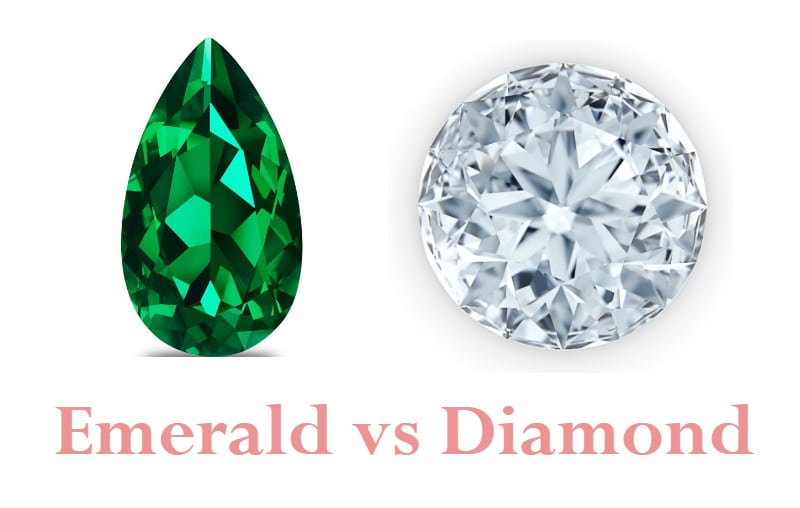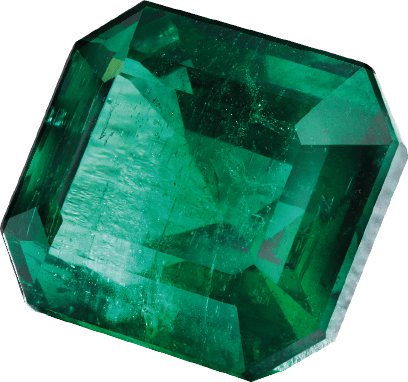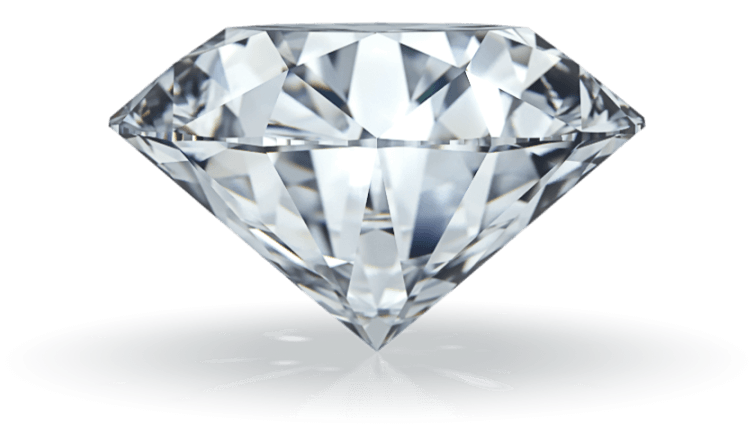Diamonds and emeralds are among the most beautiful gemstones in the world. A comparison between the two gemstones might seem like comparing apples and oranges. But people value the gems for quite similar reasons despite those differences.
Gemstones are usually compared by color, sparkle, brilliance, hardness, clarity, cut and price. This article will contrast and compare the gems using those criteria. The results of these comparisons will show whether emeralds or diamonds are the more precious gemstone.

Difference in Color
The emerald vs diamond comparison begins with color. People look at each gem with a very different idea of perfect coloration. A diamond should be clear, while emeralds possess a deep green color. While the colors are different they still share a similar trait. People look at one color as the preferred state for a gem. As such, one can look at how these gemstones compare in terms of how often colors appear.
The deeper an emerald green hue, the higher its carat value. A perfect example will equal out to tens of thousands of dollars per carat due to scarcity. A very clear diamond is valuable, but less rare. This equals out to prices often half that of a comparably perfect color in emeralds. This makes emeralds more precious when it comes to color.
Difference in Sparkle
A gemstone’s sparkle is the result of multiple properties working in unison. This makes sparkle a unique identifier for most gemstones. The type of sparkle is usually limited to select ranges of stones. Additionally, the surface of a diamond adds additional scintillation to the sparkle. This instantly provides diamonds with a higher than average level of sparkle.
Conversely, an emerald shouldn’t sparkle. There might be a subtle fire effect within an emerald when it’s exposed to light. But in general if an emerald has a sparkle somewhat closer to that of a diamond than it’s a sign of lower overall quality.
The differences in sparkle will essentially come down to personal preference. But in terms of how precious the stone is, additional rare factors increase overall value. Therefore the more complex nature of a diamond’s sparkle makes it a more precious gemstone.

Difference in Brilliance
Brilliance is one of the easier items to measure in the emerald vs diamond comparison. A gem’s brilliance is a measure of general refractive index levels. As the name suggests, the RI value measures how well an item refracts light. The higher the RI value the more a gemstone sparkles.
Diamonds have a fairly high RI which averages out at 2.4. Emeralds average out with a RI of 1.57 to 1.58. Diamonds obviously have a higher RI value on average. There’s still some points to consider though. If one values brilliance, than it’s much easier to find in a diamond. Meanwhile emeralds on the upper side of their range are more rare.
When looking at how precious a stone is one should consider overall scarcity of a trait. Therefore an emerald with a higher than average sparkle would be more rare than a diamond which sat in the same overall percentile.
Difference in Hardness
Hardness is another fairly easy category for an emerald vs diamond comparison. Diamonds are so hard that it’s usually considered a defining trait. Gemstones are usually rated on the Mohs Scale of Hardness. Diamonds sit on the very top of that ranking, with a Mohs rating of 10. Emeralds rank at 7.5 to 8.
The variability in an emerald’s score might shift scarcity in favor of harder variants. However, hardness is also synonymous with durability. And the durability of an investment is of more importance than sheer probability of finding it in nature. As such, the emerald vs diamond comparison of hardness comes out in favor of diamonds. Diamonds are simply more practical to actually wear or showcase than emeralds.

Difference in Clarity
Clarity refers to the level of imperfections within a gemstone, called inclusions. Any naturally formed stone will have some level of inclusion. But the emerald vs diamond comparison will showcase two very different measures of clarity.
Diamonds typically have very high levels of clarity. As a result, inclusions will typically only be notable when using some form of visual magnification. Emeralds are almost the exact opposite. An emerald with no visible inclusion is quite rare and will instantly increase the overall value of the gemstone.
As a result, people should consider clarity in emeralds as a far more valuable and precious trait. This makes emeralds a clear winner when it comes to comparisons of clarity.
Difference in Cut
People often assume that the most common representations of a gem’s shape is natural. But in reality the shape of a gemstone has been created by talented craftsman. The cut of a stone creates some beautiful effects in overall presentation. However, it’s usually limited by expectation. Diamonds and emeralds have standard cuts which people expect when they’re browsing a collection.
The main difference between the cut of a diamond and emerald is surface area. An emerald cut will typically provide a much larger surface area than a comparable diamond cut. The end effect is that the average diamond cut will have more intrinsic value than the average emerald cut. This gives the advantage to diamonds due to the fact that a diamond cut is seldom used with emeralds.
Difference in Price
The final price of either emeralds or diamonds will depend on how they combine all other values. But in general one can reduce the discussion down to averages. Framing the emerald vs diamond discussion around averages makes carat values the primary metric.
Emeralds average out at around $500 per carat. The average carat value of a diamond is around $3,250. Of course extremes exist on either end. An especially exquisite combination of traits might raise an emeralds overall value to a maximum of around $27,000 per carat. But it’s best to go by averages when looking at general price comparisons. This makes diamonds more expensive, and therefore more precious.
The Bottom Line
The final conclusion needs to take every rating into account. Emeralds do come out ahead when looking at color, especially if you’re shopping for a more modern, unique engagement ring. One finds significant variation in the overall acceptable color scheme for emeralds. Even imperfections can influence an emerald’s value by influencing color.
Diamonds come out significantly far ahead in most ratings though. Price points, in particular, make diamonds far more precious. Exceptions can be made for top tier emeralds. But in general, one can assume that any diamond is more precious than any emerald.






